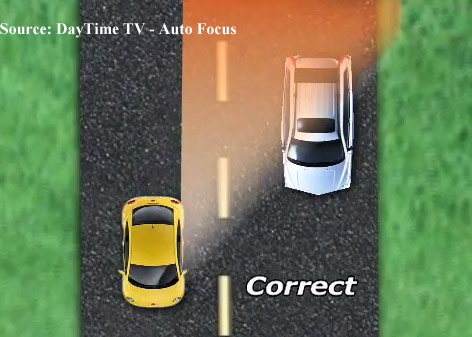3 Steps to Avoid Blind Zone Dangers
October 7, 2013 | Category: Automobile Accidents | ShareIn the U.S. every year there are approximately 840,000 side-to-side blind spot vehicle collisions with 300 fatalities, according to the National Highway Traffic Safety Administration (NHTSA). Many side-view mirrors are set so the driver can see the side of their vehicles. This may cause the side-view mirrors to overlap which creates blind spots.
Kerry Donnelly of AAA's Driver Training Department says, "Most drivers turn their mirrors too far in toward the car. It's familiar and comfortable to most people, but it can compromise visibility." Donnelly suggests drivers try the Blind Spot-Glare Elimination (BGE) method. The BGE approach positions the mirrors farther out than most of us are used to, but it can do wonders in fighting blind spots.
Here is his step-by-step approach:
1. Sit in the driver's seat and place your head flush against the driver-side window. While in that position, adjust the driver-side mirror until the edge of the car is just barely visible in the mirror.
2. Lean your body to the right so that your head is directly below the rearview mirror or above the center console, and adjust the passenger-side mirror until the edge of the car is just barely visible in the mirror.
3. Check the mirror adjustment by having someone walk around the vehicle. Adjusting mirrors this way lets a car pass almost seamlessly from one mirror to another.
Adjusting the rearview mirror is also important. DayTimeonline.tv offers suggestions on how to adjust not only side mirrors, but also rearview mirrors. Click on Auto Focus for more information.
Setting a vehicle's mirrors to avoid "blind spot" accidents is important to motorist safety. Often, however, when travelling and renting a vehicle, motorists may not remember to set the mirrors before leaving the rental agency parking lots. With many drivers of varying stature renting vehicles, most likely the mirrors will need adustment.
Once all the mirrors are set to the correct position, a further safety precaution is "look before changing". Looking in the mirrors then turning the head for a quick glance over the shoulder will allow motorists to ensure there is no other vehicle in the lane beside them. Then, immediately before turning the steering wheel to navigate the lane change, check once again.
The automobile manufacturer, Volva introduced the first factory-installed "Blind Spot Information System (BSIS)" in 2005 for its luxury vehicles. Since then, factory-installed BSISs have become more accessible in the lower end market. The aftermarket industry was quick to try to fill the need for blind spot warning devices and has several currently on the market.
"Whether motorists have factory-installed, aftermarket-installed, or no automated warning systems," Fort Myers Personal Injury Attorney, Randall L. Spivey recommends, "driving with caution and always looking before changing lanes.
Florida Accident Attorney, Randall L. Spivey is a Board Certified Civil Trial Attorney – the highest recognition for competence bestowed by the Florida Bar and a distinction earned by just one (1%) percent of Florida attorneys. He has handled over 2,000 personal injury and wrongful death cases throughout Florida. For a free and confidential consultation to discuss your legal rights, contact the Spivey Law Firm, Personal Injury Attorneys, P.A., in Lee County at 239. 337.7483 or toll free at 1.888.477.4839, or by email to Randall@SpiveyLaw.com. Visit SpiveyLaw.com for more information. You can contact Spivey Law Firm, Personal Injury Attorneys, P.A. in Charlotte County at 941.764.7748 and in Collier County 239.793.7748.

